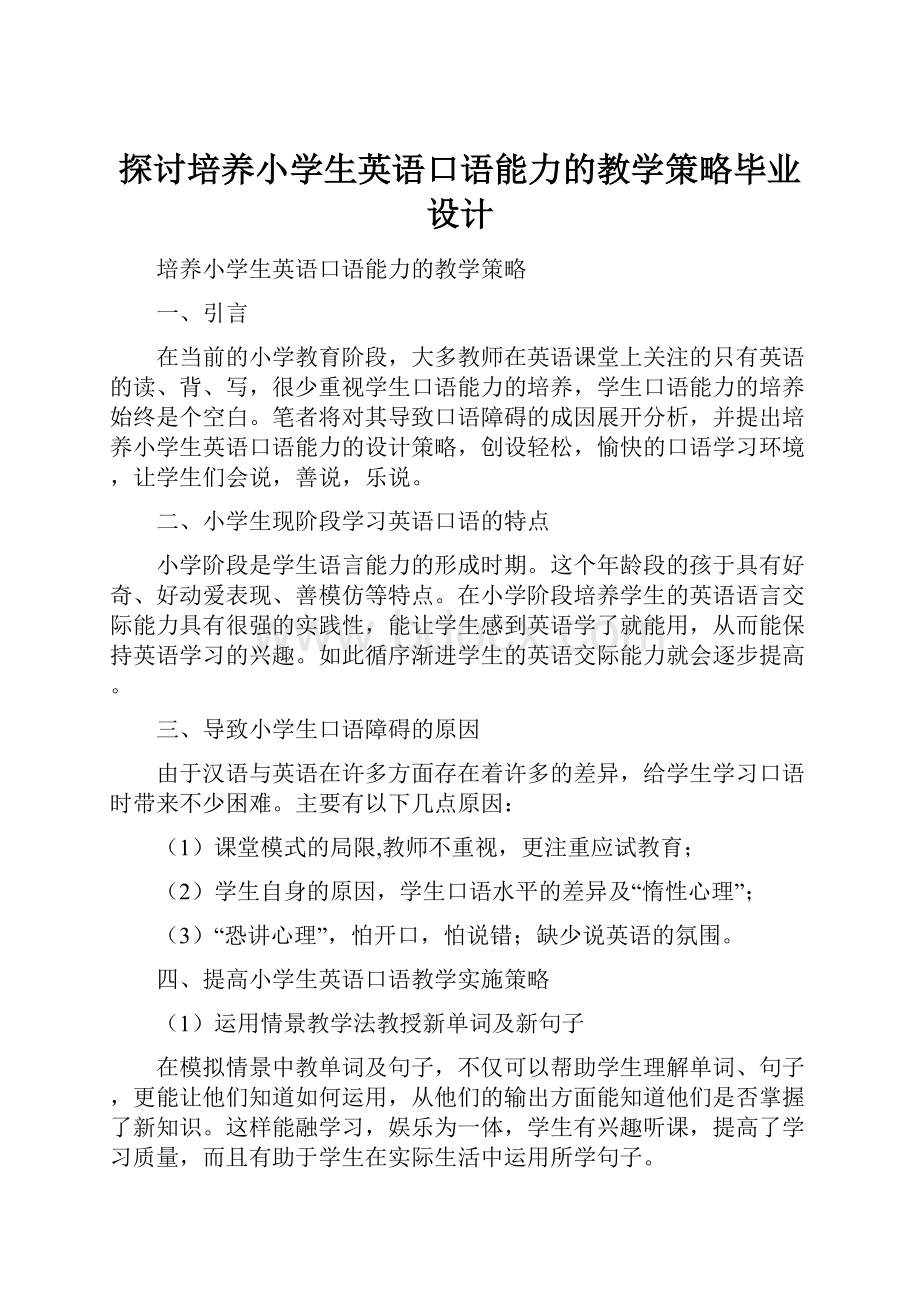探讨培养小学生英语口语能力的教学策略毕业设计.docx
《探讨培养小学生英语口语能力的教学策略毕业设计.docx》由会员分享,可在线阅读,更多相关《探讨培养小学生英语口语能力的教学策略毕业设计.docx(17页珍藏版)》请在冰豆网上搜索。

探讨培养小学生英语口语能力的教学策略毕业设计
培养小学生英语口语能力的教学策略
一、引言
在当前的小学教育阶段,大多教师在英语课堂上关注的只有英语的读、背、写,很少重视学生口语能力的培养,学生口语能力的培养始终是个空白。
笔者将对其导致口语障碍的成因展开分析,并提出培养小学生英语口语能力的设计策略,创设轻松,愉快的口语学习环境,让学生们会说,善说,乐说。
二、小学生现阶段学习英语口语的特点
小学阶段是学生语言能力的形成时期。
这个年龄段的孩于具有好奇、好动爱表现、善模仿等特点。
在小学阶段培养学生的英语语言交际能力具有很强的实践性,能让学生感到英语学了就能用,从而能保持英语学习的兴趣。
如此循序渐进学生的英语交际能力就会逐步提高。
三、导致小学生口语障碍的原因
由于汉语与英语在许多方面存在着许多的差异,给学生学习口语时带来不少困难。
主要有以下几点原因:
(1)课堂模式的局限,教师不重视,更注重应试教育;
(2)学生自身的原因,学生口语水平的差异及“惰性心理”;
(3)“恐讲心理”,怕开口,怕说错;缺少说英语的氛围。
四、提高小学生英语口语教学实施策略
(1)运用情景教学法教授新单词及新句子
在模拟情景中教单词及句子,不仅可以帮助学生理解单词、句子,更能让他们知道如何运用,从他们的输出方面能知道他们是否掌握了新知识。
这样能融学习,娱乐为一体,学生有兴趣听课,提高了学习质量,而且有助于学生在实际生活中运用所学句子。
(2)运用情景教学法教授新句子
通过"情境"的设置,使教学内容在情境化的故事中得以完成。
让学生扮演情境中的主角,学生在角色中要完成各种学习内容,以达到教师在课前为此预设的目标。
它始终把学生主动、全面的发展放在中心位子,在注意发挥教师主导作用的同时,特别强调学生学习主体地位的体现。
让学生在玩中学口语,自然而然地脱口而出。
(3)运用游戏寓教于乐
巧用游戏,寓教于乐。
寻求乐趣是孩子的天性,学习英语,兴趣与主动性是最重要的。
学生学习的劲头一足,就能达到学生在“玩中学,学中玩”的教学效果。
这样不仅有意义地操作了句型,而且在猜测过程中,学生获得了快乐及成就感,觉得学英语就像玩一样。
游戏还能培养学生的思维,开发他们的多元智能。
(4)运用所学到的句型及单词进行小组角色扮演
角色扮演能让学生扮演社会上的各种角色,达到真实语言的交流。
巩固之前所学的句型并学会运用到实际生活中。
真正做到让学生开口说,敢于说,会说。
(5)话题演讲
话题演讲是巩固之前所学知识的一种方法,也是考查学生是否掌握知识的方法。
教师通过预设几个话题与学生互动,操练刚学过的句型,让学生真正学会运用到实际生活中。
小组演讲环节既可以看出学生小组合作的默契,又可以培养说英语的氛围。
五、教学活动设计
Activity1:
Visitingthefruitshop
Teaching content:
(1) New words:
fruit, apple, orange, banana, watermelon, pear, strawberry
(2)Sentence structures:
I have......
There is......
There are some.....
Is/Are there any....
Yes, there is/are....
No,there isn’t/aren’t....
Introduction:
The teacher applies the Situational Approach to design a scene “Visiting the fruit shop” while the new teaching content is presented. In thisactivity the teacher will be the host of the fruit shop and the students will be the C.fifteen minutes is needed in this activity. The teacher should prepare some fruit cardsand one fruit shop picture for the teaching. It is a good idea for theteacher to guide the class to learn new language knowledge and practice usingthe language functions.
Teaching Steps/ Procedures:
Step 1:
New knowledge presentation:
After greeting between the teacher and
the class,One fruit shop picture is showed on the board(screen). And the askingand answering around visiting the fruit shop begins:
(H is the host, C is the customers)
--- H:
Dang dang dang..., look at here (point at the picture), I have a fruit shop. Is it beautiful?
There are so many fruits in my fruit shop. 0k, now, let me guide you to visit my fruit shop .
---H:
There are many fruit in my fruit shop. Look, here is an apple , Can you see some apples there?
( with the help of the apple card)
---C:
Yes, there are some apples.
---H:
Pretty good!
There are some apples . And what kind of fruit is this?
---C:
watermelon (Guide to say out)
---H:
Yes, there are some watermelon. Wow, so many strawberries, can you see them?
---C:
Yes, we can see many strawberries.
---H:
This way please, There strawberries, are some oranges, bananas ,watermelon ,and strawberry over there. Do you like them( with the help of the fruit cards)?
---C:
(Get the class to say out) I like/I don’t like
orange/banana/watermelon//strawberry.
---H:
Here are some apples and pears, there are some watermelons and strawberries over there.(get the class to repeat the fruit words)
Step 2:
Practice speaking:
---H:
So This is my fruit shop. Now, let’s have a rest there. I’d like to give yousome fruits for tasting but first of all, I want to see whether you can remember how many kinds of fruits there are in my fruit shop?
---C:
There are some....(give one the right fruit who can say it out )
--- H:
Is there any......Are there any......
---C:
Yes, there are ....../No, there isn’t any....(get the class to say and repeat the new fruit words and new sentences)
Activity2:
Whatwouldyoulike
Teachingcontent:
Words:
cake,pudding,rice,noodle,beef
Sentencestructures:
Whatwouldyoulike...
Iwouldlikesome...
Canihavesome...
Yes,hereyouare.
Introduction:
TheteacherappliestheSituationalApproachtothisactivitynamed“Whatwouldyoulike”.Thisactivitywillusefoodpictures.Theteachershowstherestaurantpictureonthescreen,andthengivethemmenustoorderthefood.Letthestudentsusethenewsentencestoorderfoodbythemselvesinfictitious situation.Thentheteacheraskstwostudentstomakedialogues.Oneplaysthecustomer,anotheroneplaysthewaiter.AndthenTheyswaptheroletomakeanotherdialogue.(Tistheteacher.Sisthestudent.Wisthewaiter.)
Step1:
learnsomenewsentences
Theteachershowssomefoodpicturestostudents.Letthestudentsreviewthewordslastclasstheyhavelearned.Thentheteacherextendsthenewsentences.
Whatwouldyoulike...
Iwouldlikesome...
Canihavesome...
Yes,hereyouare.
Whenteacherensuresthestudentsmasterthenewsentences, take the next step.
Step2:
order
Theteacherusessomefoodpicturestoshowtothestudents.
T:
Riceandnoodleareverynice.Wouldyoulikesomericeornoodle?
S:
Yes.I’dlike.
T:
RecentlyI'veopenedarestaurant.Thefoodsareverypopular.Becausetheyareverydelicious.SonowI’llgiveyouasurprise:
Iwanttotakeallofyoutomyrestaurant.Doyouwanttogo?
S:
Yes.
Theteachershowsarestaurantpictureonthescreen.
T:
Welcometomyrestaurant.Thisisthemenu.Youcantakeyourorder.Youcanorderthefoodyouliketoeat.
S1:
Whatwouldyoulike?
(Letthestudentstalkfreely.)
S2:
Iwouldlikesomerice.
Andyou?
S1:
Iwouldlikesomenoodles.
S3:
Whatwouldyoulike?
S4:
Iliketoeatdessert.SoIwouldlikesomecake.
S5:
Iwouldlikesomepudding.
S1:
Waiter,wewanttoorder.
W:
Hello,whatwouldyoulike?
(Nowtheteacherplaysawaiter.)
S1:
Iwouldlikesomenoodles.
W:
Ok,.hereyouare.
S1:
Thankyou.
S2:
Iwouldlikesomerice.
W:
Hereyouare.
S2:
Thankyou.
S3:
Iwouldlikesomebeef.
W:
Hereyouare.
S3:
Thankyou.
S4:
Iwouldlikesomecake.
W:
Hereyouare.Andyou?
S5:
CanIhavesomepudding?
W:
Yes,hereyouare.
S5:
Thankyou.
(Afterserving,Theyarehavingthemeal.)
S1:
CanIhavesomepudding?
S5:
Yes,hereyouare.(Theysharedtheirfoodwitheachother.)
S2:
CanIhavesomecake?
S4:
Yes,hereyouare.
S5:
CanIhavesomebeef?
S3:
Yes,hereyouare.
Step3:
makedialogues
Thisparttheteacheraskstwostudentstomakedialogueswithpartner.Oneplaysthecustomer,anotheroneplaysthewaiter.Thereisasituation,supposeonestudentisthecustomer,hewanttogototherestauranttoeatlunch.Whatwouldhesaytothewaiter.Expressideasonthistopic.Refertothewordsandexpressionsontheblackboard.Andthenswaptheroletomakeanotherdialogue.Justtwominutestodiscuss.
(Twominuteslater)
T:
Ok.Nowwhowanttohaveatry?
S1:
Wewanttohaveatry.
T:
Ok,youtwo,please.
S2:
Waiter.(S2playsthecustomer.)
S1:
Nicetomeetyou.Whatwouldlike?
(S1playsthewaiter.)
S2:
Iwouldlikesomenoodles.
S1:
Anythingelse?
S2:
Iwouldlikesomebeef.That’sall.
S1:
Pleasewaitamoment.
S2:
Ok,thanks.
S2:
Youarewelcome.(Theyswaptheroletomakeanotherdialogue.NowS1playsthecustomer.S2playsthewaiter.)
S1:
Excuseme,couldiseethemenu,please?
S2:
Yes,hereyouare.Areyoureadytoorder?
S1:
Yes.Iwouldlikesomecakes.
S2:
Anymainfood?
S1:
Iwouldlikesomebeef.Canihavesomerice?
S2:
Sure.Anythingmore?
S1:
No,that’senough.Thankyou.
S2:
Youarewelcome.Pleasewaitamoment.
(Theconversation ends.Bytheteacher'spraise.)
Step3:
prize-giving
Thisparttheteacherwillgivetheprizetothestudentsthathavemadedialogues.Fromthislink,thestudentswillarousetheirinterestedinoralEnglish.Takemoreattentionintotheclassandlearnmoreknowledgeintherelaxedenvironment.
Activity3:
Guessinggame
Teaching content:
(1) New words:
hill,mountain,forest,lake,bridge,river.
(2) Sentence structures:
There is /are…
Is/are there…
Yes,there is/are.
No,there isn't/aren't.
Introduction:
In order to review and consolidate what the students learned in the last period, the teacher applies the Situational Approach to design a scene“talking about a nature park” to this activity named “Guessing game” at the begi-nning of the class. In this 15-minute’s activity, the students are asked to use the words and sentence patterns to play the game according to the rules.Some animal pictures and cards will be used in this activity.
Teaching Steps/ Procedures:
Step 1:
The teacher shows the class some places pictures and gets the class tosay out the places on the picture together.
step 2:
To get some students to go to the front of the class and play as the teacher , who points at the picture and says out the places on the picture like this“There is a mountain”, to check whether the students can say out the words they learned in last period.
step 3:
The teacher tells the class to be going to play a game named “guessing game”,but first, to check whether the students have prepared some animal cards or pictures for the game.(the students were asked to prepare animal cards before this lesson ) .
step 4:
After finishing checking, the teacher shows the rules of the game to the class:
1. Using the places cards to play the game in groups
2. To make a dialogue :
One student asks the others in the group